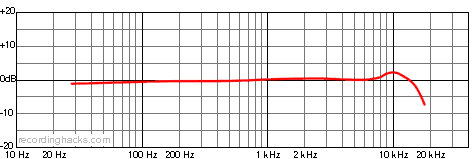 Soundelux U99B
Soundelux U99B
Multi-Pattern Tube Condenser Microphone
The Soundelux U99 is a multipattern, large-diaphragm tube microphone. It was positioned as an improvement over the company’s former flagship tube condenser, the U95.
The mic went through numerous revisions, incorporating different components at various times in its history.
David Bock
[T]here were a few versions of [the U99]. It started out with a new Russian EF86 [tube], Latvian 67-type capsule, and a Reichenbach transformer. It was then changed to an NOS PF86 tube, which sounded so much better it got it’s own name of U99B. Then the whole thing changed to a one-piece body, with an NOS EF7323 submini tube, German 67-type capsule, and Lundahl transformer. The very last ones had the addition of a high cut switch in the mic.
The “Latvian” capsule was manufactured by BLUE. It was a 1'' diameter, dual backplate, dual membrane design. The diaphragms were made of 6-micron Mylar, sputtered with an alloy of gold and aluminum, then hand-tuned during assembly. The backplate design is from the K67 family.
The 6072A tube in the U95 was thought to be too hard to find in quantity, so the early U99s utilized an EF86 pentode vacuum tube, wired as a triode. Soundelux staff hand-selected each tube after measuring them for distortion, signal handling and noise specifications. The electronics package uses only 12 components.
The U99 has no internal connectors, favoring direct soldering only to retain signal purity. There are no switches or screws on the mic body, which is made of nickel, chrome and brass alloy.
The electronics have been configured in a zero-feedback arrangement for maximum transient response and absolute phase coherency. This is the most direct and true manner in which to translate sounds from the acoustic to the electronic medium.
The mic’s oversized, regulated power supply can deliver up to four times the current required by the microphone.
Unlike the U95, which provided 9 discrete polar patterns, the U99 introduced a continuously variable polar pattern mechanism, which can be swept smoothly from omnidirectional to Figure-8.
MIX
When creating the U99, Soundelux was aiming at less of a bump in the high end, a flatter midrange, better bass response and a lower noise floor in comparison to the U95. The designers have more than achieved their goals — the U99 captures the natural warmth of a performance without an overexcited top end.
Soundelux has really created a great vocal mic. Of course, different vocalists prefer different mics, but the U99 stands a good chance at pleasing everybody. This mic brought out the best qualities of every voice I tried…
Ty Ford
In comparison with a Neumann TLM 103, the U 99 showed itself to be only 1-2dB less sensitive and with slightly less upper bass than the TLM 103. I had positioned the mics several inches apart and was speaking at them from about two inches. The difference in low end and output were slight enough so that shifting my position slightly toward the U 99, thereby increasing the gain and proximity, allowed me to inter-cut the tracks without being able to tell them apart.
Permalink: Soundelux U99B
The mic was released in 2000.
Specifications
| Frequency Response - CardioidClick Graph to Compare! |
|---|
 |
| Pickup Patterns | Pads & Filters |
|---|---|
|
Omnidirectional
(21 mV/Pa; 20 - 20,000 Hz) Cardioid (21 mV/Pa; 20 - 20,000 Hz) Bidirectional (21 mV/Pa; 20 - 20,000 Hz) |
|
| Capsule Dimensions | Impedance | SPL/Noise |
|---|---|---|
| Diaphragm diameter: 25mm Diaphragm gauge: 6 microns |
200 Ohms (Low) | Max SPL: 130 dB Self-noise: 17.0 dB(A) |
| Weight | Length | Max Diameter | Interface(s) |
|---|---|---|---|
| 763g (26.91oz) | 229mm (9.02'') | 52mm (2.05'') |
|
| Power Specifications |
|---|
|
Did we get anything wrong on this page? Please let us know!


